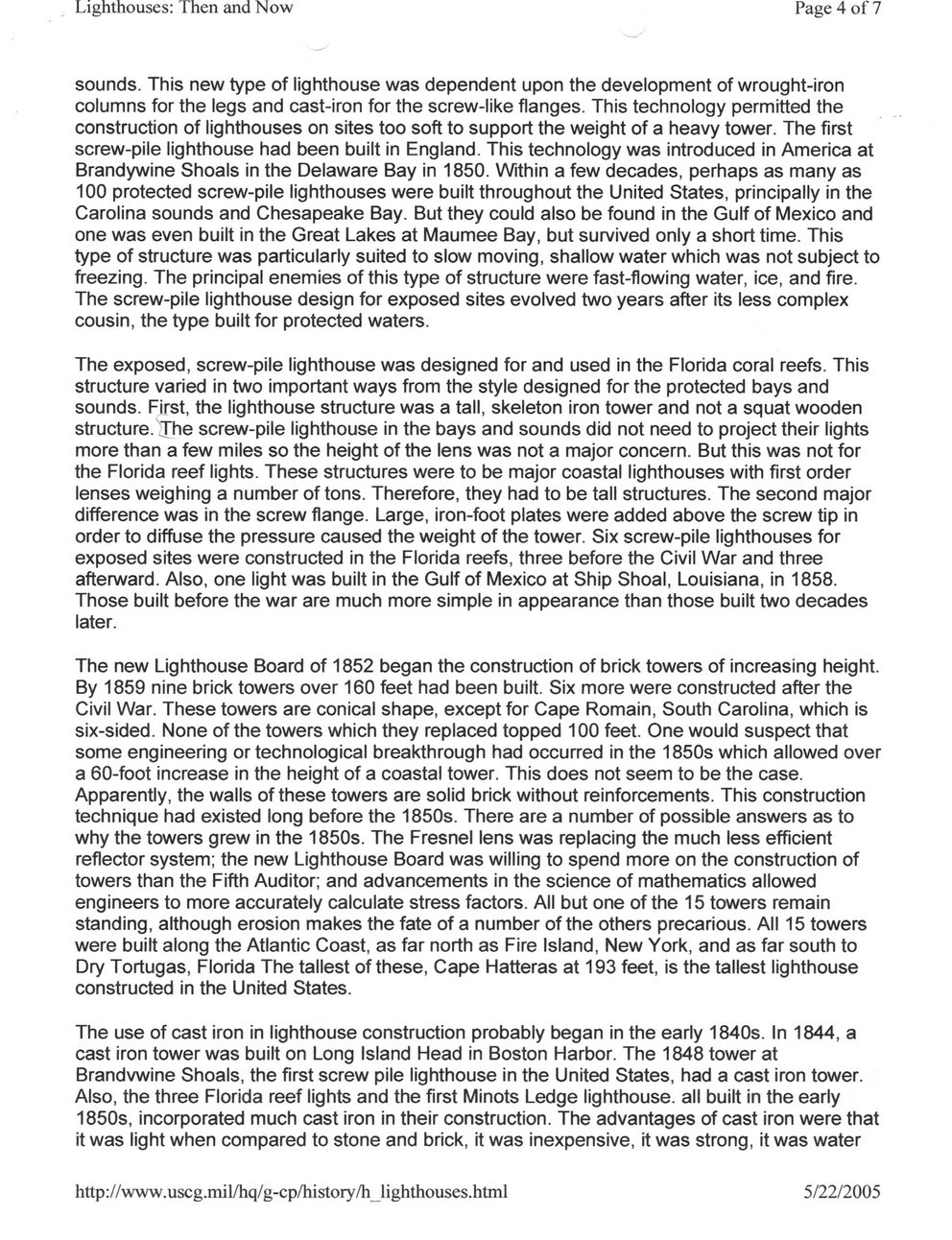This text was obtained via automated optical character recognition.
It has not been edited and may therefore contain several errors.
Lighthouses: Then and Now Page 4 of 7 sounds. This new type of lighthouse was dependent upon the development of wrought-iron columns for the legs and cast-iron for the screw-like flanges. This technology permitted the construction of lighthouses on sites too soft to support the weight of a heavy tower. The first screw-pile lighthouse had been built in England. This technology was introduced in America at Brandywine Shoals in the Delaware Bay in 1850. Within a few decades, perhaps as many as 100 protected screw-pile lighthouses were built throughout the United States, principally in the Carolina sounds and Chesapeake Bay. But they could also be found in the Gulf of Mexico and one was even built in the Great Lakes at Maumee Bay, but survived only a short time. This type of structure was particularly suited to slow moving, shallow water which was not subject to freezing. The principal enemies of this type of structure were fast-flowing water, ice, and fire. The screw-pile lighthouse design for exposed sites evolved two years after its less complex cousin, the type built for protected waters. The exposed, screw-pile lighthouse was designed for and used in the Florida coral reefs. This structure varied in two important ways from the style designed for the protected bays and sounds. First, the lighthouse structure was a tall, skeleton iron tower and not a squat wooden structure. The screw-pile lighthouse in the bays and sounds did not need to project their lights more than a few miles so the height of the lens was not a major concern. But this was not for the Florida reef lights. These structures were to be major coastal lighthouses with first order lenses weighing a number of tons. Therefore, they had to be tall structures. The second major difference was in the screw flange. Large, iron-foot plates were added above the screw tip in order to diffuse the pressure caused the weight of the tower. Six screw-pile lighthouses for exposed sites were constructed in the Florida reefs, three before the Civil War and three afterward. Also, one light was built in the Gulf of Mexico at Ship Shoal, Louisiana, in 1858. Those built before the war are much more simple in appearance than those built two decades later. The new Lighthouse Board of 1852 began the construction of brick towers of increasing height. By 1859 nine brick towers over 160 feet had been built. Six more were constructed after the Civil War. These towers are conical shape, except for Cape Romain, South Carolina, which is six-sided. None of the towers which they replaced topped 100 feet. One would suspect that some engineering or technological breakthrough had occurred in the 1850s which allowed over a 60-foot increase in the height of a coastal tower. This does not seem to be the case. Apparently, the walls of these towers are solid brick without reinforcements. This construction technique had existed long before the 1850s. There are a number of possible answers as to why the towers grew in the 1850s. The Fresnel lens was replacing the much less efficient reflector system; the new Lighthouse Board was willing to spend more on the construction of towers than the Fifth Auditor; and advancements in the science of mathematics allowed engineers to more accurately calculate stress factors. All but one of the 15 towers remain standing, although erosion makes the fate of a number of the others precarious. All 15 towers were built along the Atlantic Coast, as far north as Fire Island, New York, and as far south to Dry Tortugas, Florida The tallest of these, Cape Hatteras at 193 feet, is the tallest lighthouse constructed in the United States. The use of cast iron in lighthouse construction probably began in the early 1840s. In 1844, a cast iron tower was built on Long Island Head in Boston Harbor. The 1848 tower at Brandvwine Shoals, the first screw pile lighthouse in the United States, had a cast iron tower. Also, the three Florida reef lights and the first Minots Ledge lighthouse, all built in the early 1850s, incorporated much cast iron in their construction. The advantages of cast iron were that it was light when compared to stone and brick, it was inexpensive, it was strong, it was water http://www.uscg.mil/hq/g-cp/history/h_lighthouses.html 5/22/2005

Lighthouses Chronology-of-Aids-to-Navigation-(04)-(1)